Gradual fall in underlying inflation keeps rate cut bets alive
Australia’s inflation rate remains too high for the Reserve Bank, but a slightly higher than expected CPI indicator for July doesn’t change the fact that underlying inflation is coming down.

Business
Don't miss out on the headlines from Business. Followed categories will be added to My News.
The inflation rate remains too high for the Reserve Bank but a slightly higher than expected monthly CPI indicator for July doesn’t change the fact underlying inflation is coming down.
Consistent with hawkish RBA guidance, the vast majority of market economists expect the central bank to hold its cash rate target at a 13-year high of 4.35 per cent until February or later.
That view was reinforced after the CPI indicator rose 3.5 per cent versus expectations of an even sharper deceleration from 3.8 per cent to 3.4 per cent on the back of state and federal electricity subsidies that started to be introduced last month.
But after a slight adjustment, the money market was still priced for almost one 25 basis point rate cut by December, at least three cuts within 12 months, and no chance of any more hikes.
The Aussie dollar briefly hit an eight-month high of US68.13c but the S&P/ASX 200 share index remained near record highs above 8100 points after recovering from a dip to 8008.9.
Government bond yields gained after sharp falls in anticipation of rate cuts globally.
The bond market may be an imperfect predictor of the interest rate outlook but it probably has a better track record than the consensus of market economists and central banks.
There have only been a handful of RBA easing cycles in the inflation-targeting era to gauge how it will react to disinflation and that “reaction function” has evolved over time.

The pandemic response caused major economic distortions that are still working their way through the global economy, and monetary policy needs to be pre-emptive given the lags inflation expectations are “still anchored” according to the RBA, and underlying inflation is still falling.
The RBA said the June quarter CPI data showed inflation was “proving persistent and the quarterly underlying inflation rate had fallen very little over the past year.
But after spiking to 1.8 per cent (7.2 per cent annualised) in the September quarter of 2022, underlying inflation has fallen a long way to its June quarter level of 0.8 per cent. It would not be a stretch for six-month annualised inflation to hit the top of the 2-3 per cent target band when the June quarter data is released on September 25.
The RBA may have doubts about whether faster than expected disinflation is sustainable. In its August Statement on Monetary Policy, it said underlying inflation “remains too high and it will be some time yet before inflation is sustainably in the target range”.
“Data have reinforced the need to remain vigilant to upside risks to inflation,” it added.
However, price measures in NAB’s Monthly Business Survey suggest Australia’s “bumpy disinflation” will continue. Notwithstanding the incomplete picture of inflation afforded by the monthly CPI indicator, annual trimmed mean inflation fell to a six-month low of 3.8 per cent year-on-year after spiking to 4.4 per cent in May. It’s not all about the electricity rebates.
“This suggests underlying disinflation is resuming after some reacceleration earlier this year, similar to what we saw in the US,” ANZ senior economist Catherine Birch said.
“We do not think today’s print will affect the RBA’s thinking, especially given it was the first month of the quarter, when a much lower share of services and non-tradeable goods have price changes measured compared with goods and tradables.”
But apart from the impacts of the energy bill relief, the disinflationary impulse continued to broaden and the number of items in the CPI basket with annual inflation below 2 per cent continued to rise. As of July, that group outnumbered the number of items with prices growing above the RBA’s inflation 2-3 per cent target band, and the number in that group continued to fall.
“Measures of core inflation also eased in the month,” said CBA economist Stephen Wu. “In other words, disinflation is not occurring purely because of government rebates. The news is good.”
However, UBS cautioned that underlying inflation was “still very sticky”. Trimmed mean inflation was the lowest since January and goods inflation fell to 2.8 per cent, but services inflation ticked up to a “sticky” 4.4 per cent year-on-year. Tradables inflation rose to 1.5 per cent. Non-tradables inflation was “still high” at 4.5 per cent, but the lowest since February 2022.
“The biggest surprise to our forecast was electricity prices, which fell materially less than we expected, down by only 6.4 per cent month-on-month July,” said UBS economist Nic Guesnon.
HSBC said the indicators of underlying inflation in the monthly CPI, while “volatile and partial”, highlighted that the “gradual disinflation process that has been under way for some time is continuing”.
But measures of underlying inflation, while easing slowly, are still well above the midpoint of the RBA’s 2-3 per cent target band, HSBC noted.
“In short, underlying inflation is too high and only gradually easing, and the jobs market is still tight and only gradually loosening, mostly from the supply side, with employment still strong,” said HSBC chief economist Paul Bloxham. “Indeed, underlying inflation is still noticeably higher in Australia than in other comparable economies where the respective central banks have either cut or given guidance that a cut is coming,” he said.
More Coverage
Originally published as Gradual fall in underlying inflation keeps rate cut bets alive









